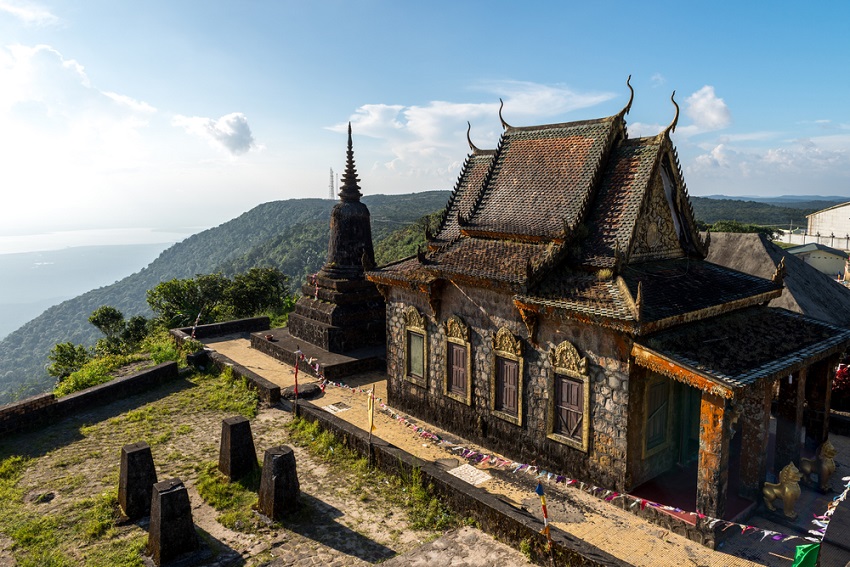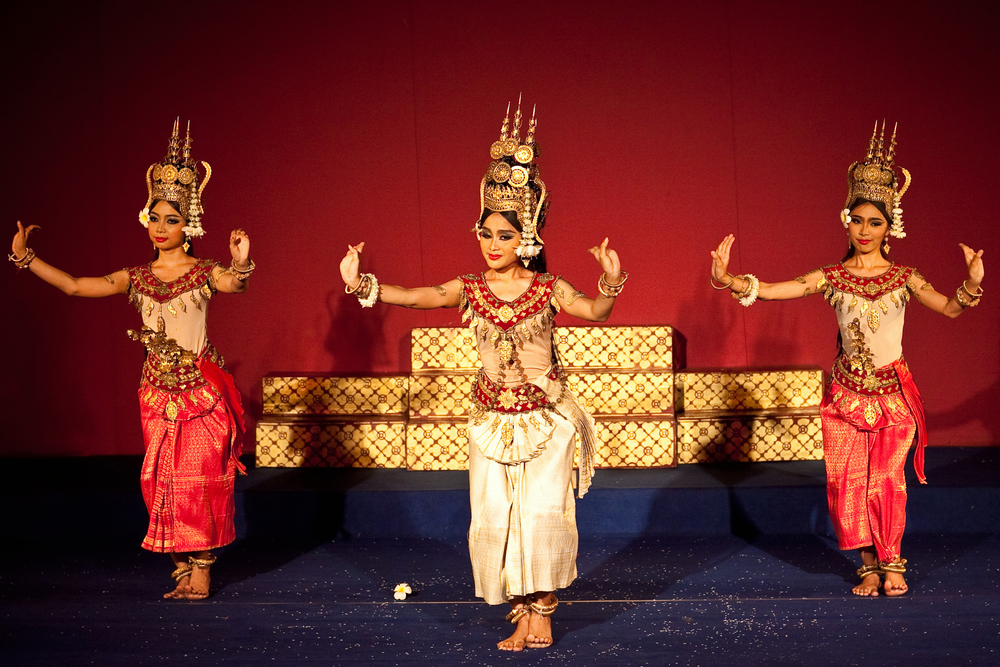Cambodia - belief and religion
It is known that 96% of Cambodians were Buddhists followed by Muslims (2%) and Christian (0.4%) (Wikipedia the Free Encyclopedia, 2016). On the other hand, according to a report from Religion in Southeast Asia, even though 96% of Cambodians were Buddhists and 90% of them were Theravada, Cambodian still believed in ancestor ghosts, the supernatural and animismfrom the past to this present day. They worshiped soil, water, wind, fire, mountain, and trees (Indochina Studies Center Burapha University, p.92). Even thoughBrahmanism and Buddhism influenced Cambodian culture later on, we could see trails of supernatural beliefs in many rituals such as Sandonta ceremony that dedicated to ancestor ghosts.
Indigenousbelief of Cambodian was associated with ancestors which was shown in terms of “Meba” and “Neak Ta”. Meba represented ancestor spirits that they respected. The story of Meba started from the ancient belief in the Nakhon Phanom era in Cambodia. They believed that this land was once governed by Soma, a female king who married to a Brahman named Kaundinya. This belief indicated thata female-dominated culture rooted in Cambodia and associated with the word “Me” which meant “Mother” or “female ancestor” and “Ba” which meant “Father” or “male ancestor”. Cambodian believed that they need to inform Meba about everything they do, also apologize to Meba through an offering ceremony if they commit something wrong. (นรเศรษฐ์ พิสิฐพันพร, 2557:18)
On the other hand, Neak Ta referred to ancestor spirits that protects their descendants. A ceremony called Sandonta needed to be done every yearto worshipNeak Ta. Cambodian really were afraid of Neak Ta especially the one that they were not familiar with. Since Neak Ta was the ruler of land, forest, and villages, Cambodian hesitated to move in the place where they did not familiar with Neak Ta that protected the property. (นรเศรษฐ์ พิสิฐพันพร, 2557:20)
However, belief and faith in Meba and Neak Ta still carry on till today even though the influence of Brahmanism and Buddhism has come to this region. Even when other religious architectures were built by kings, this belief was not shaken in Cambodian’s heart.
Brahmanism
Brahmanism was an old religion in Cambodia even though it came after a belief in supernatural power. It had a strong influence in Cambodia. Many temples and castles were built to worship gods in Brahmanism.
From the work of art and other documents, we could imply that Brahmanism found its way into Cambodia during the Funan era in the 5th century. Brahmanism in Cambodia could be divided into Shaivism which worshiped Shiva as the Supreme Being and Vaishnavism which considered Vishnu or Phra Narai as the Supreme Lord. (รุ่งโรจน์ ธรรมรุ่งเรือง และ ศานติ ภักดีคำ, 2557:43)
However, the record showed that there were less architectures built for Vishnu than Shiva. Until a king named Suryavarman II, who deeply respect Vishnu, built Angkor Wat to worship his beloved god. After this death, Suryavarman II was known as Paramavishnuloka reflected to the belief that after passing on, he would join and become one with Vishnu. (รุ่งโรจน์ ธรรมรุ่งเรือง และ ศานติ ภักดีคำ, 2557:43)
After that, in 1181, the era of Suryavarman VII, the influence of Brahmanism had decreased since the king turned to Mahayana Buddhism followed by the increase of Theravada Buddhism influence in Cambodia. Brahmanism has lost its importance to ancient belief and Buddhism; however, we still see its trace in royal ceremony such as Ploughing Ceremony (รุ่งโรจน์ ธรรมรุ่งเรือง และ ศานติ ภักดีคำ, 2557:45)
Buddhism
96.9 % of Cambodians were Buddhism and 90 % of them were Theravada. The reason why Buddhism became a significant religion in Cambodia might be because it was adopted by the monarchy similar to Thailand. However, this hypothesis still needed further studies to verify the truth.
Buddhism first came into Cambodia, in the same time with Brahmanism, during Funan era. In the 12th century, Theravadalater came into Cambodia and gained its popularity over 90% of the population. (Indochina Studies Center Burapha University, p.93)
Later on, Cambodia was under the control of Red Khmer which was the time when Buddhism reached its lowest pitch. Monks wereforced to leave their monkhood, married or killed. Temples and other Buddhist architectures were destroyed. (ยงยุทธ บุราสิทธิ์, 2557:72) Nevertheless, in 1979 after the Red Khmer era ended, Buddhism was restored and supported by the government until today.
Buddhism does not only have an important influence in people’s belief, it is also important to society and politics. It is a way of living that people are look up to. Some politicians even used Buddhism to set an example for people in the countries in some eras. For example, Heng Samrin, a former Cambodia Leader after the Khmer Rouge regime, praised that Buddhism was an important moral power that would help to shape a new society. Later, when Son Sann became the Prime Minister of the Coalition Government of Democratic Kampuchea, he believed that Buddhism was a culture foundation and way of living of Cambodian people. He also believed that it would be an essential factor to unite the nation as one. Moreover, another sample of Buddhism influence to Cambodia (Yongyuth Burasit, 2557:74) was that it became the national main religion at the same time that the leader did not limit the freedom of choosing other religions.
Conclusion
This topic covered religions and beliefs in Cambodia in brief. First, it referred to a traditional belief of Cambodian, their belief in ancestor spirit (called Meba and Neak Ta). Later, even when Brahmanism and Buddhism had more influence on people’s beliefs, their indigenous belief was well respected. We can conclude that religions and beliefs in Cambodia cannot be completely separated as there is an overlapping area between indigenous beliefs,Brahmanism and Buddhism. It represents clearly through religion rites such as Sandonta Ceremony. This ceremony is held to venerate the ancestor spirits. Meanwhile, there is a practice to offer food to the monks in hope that their ancestor spirits can rest in peace. It is noticeable that Brahmanism has more influence on royal ceremonies than to people’s way of living. It retains its influence in ceremonies that are important to both royal court and people such as the Royal Ploughing Ceremony that continued from the past until the present days. These ceremonies still need to be lead by Brahman leader.
Bibliography
Noraseth Pisitpanporn. (2557). Cambodia Vision. In Saowapa Pornsiripong, Studying Neighbouring Country: Cambodia in Sociocultural Aspect (page 15-55). Nakhon Pathom: Research Institute for Languages and Cultures of Asia, Mahidol University.
Yongyuth Burasit. (2557). Buddhism Relationship Cambodia-Thai. In Saowapa Pornsiripong, Studying Neighbouring Country: Cambodia in Sociocultural Aspect (page 57-103). Bangkok: Research Institute for Language and Cultures of Asia, Mahidol University.
Rungroj Thamrungrueng and Santi Pakdikam.(2557). Cambodian Arts. Bangkok: Matichon.
Indochina Studies Center, Graduate School of Public Administration, Burapha University.(n.d.).Basic Information of Kingdom of Cambodia. Chonburi: Indochina Studies Center, Graduate School of Public Administration, Burapha University.





